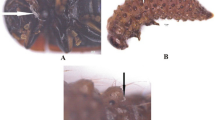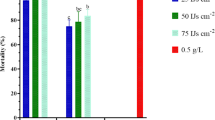Abstract
Holotrichia longipennis Blanch. (Coleoptera: Scarabaeidae) is a serious pest of commercial crops in Siduwa, Dhankuta, Nepal. Seven indigenous isolates of entomopathogenic nematodes (Steinernema lamjungense LMT5, S. lamjungense SS4, S. everestense DKP4, S. abbasi CS1, S. sp. KL1, Heterorhabditis indica CK2 and H. indica CK6) were used in a series of bioassays against the insect. All isolates showed an increased dispersal in response to H. longipennis. Nematodes were more attracted towards third instar larvae than to second instars. Differences in penetration and multiplication in the insect were observed amongst the seven isolates. Steinernema lamjungense LMT5, S. everestense DKP4 and S. abbasi CS1 caused greater mortality than other isolates to different developmental stages. Pupae and second instar larvae were more susceptible than third instar larvae. Significant differences were observed in LT50 values of the isolates against different stages of H. longipennis. Three isolates (S. lamjungense LMT5, S. everestense DKP4 and S. abbasi CS1) along with a commonly used insecticide (chlorpyrifos) were tested against this insect in pot and field experiments. In pot experiments using maize and cabbage as a host crop, S. lamjungense LMT5 and S. everestense DKP4 performed better than S. abbasi CS1 and yielded a mortality comparable with chlorpyrifos. Similar results were observed in field experiments 3 weeks after nematode application. These experiments overall suggest S. lamjungense LMT5 to be a promising biocontrol agent against H. longipennis followed by S. everestense DKP4 and S. abbasi CS1.







Similar content being viewed by others
References
Abbott WS (1925) A method for computing the effectiveness of an insecticide. J Econ Entomol 18:265–267
Ansari MA, Ali F, Moens M (2006) Compared virulence of the Belgian isolate of Steinernema glaseri (Rhabditida: Steinernematidae) and the type population of S. scarabaei to white grub species (Coleoptera: Scarabaeidae). Nematol 8:787–791
Bhatnagar A, Shinde V, Bareth SS (2004) Evaluation of entomopathogenic nematodes against Maladera insanabilis Brenske. Int J Pest Manag 50:285–289
Cui LR, Gaugler R, Wang Y (1993) Penetration of steinernematid nematodes (Nematoda: Steinernematidae) into Japanese beetle larvae, Popillia japonica (Coleoptera: Scarabaeidae). J Invertebr Pathol 62:73–78
Ehlers R-U (1996) Current and future use of nematodes in biocontrol: practice and commercial aspects in regard to regulatory policies. Biocontrol Sci Technol 6:303–316
Ehlers R-U (2001) Mass production of entomopathogenic nematodes for plant protection. Appl Microbiol Biotechnol 56:623–633
Elawad SA, Goven SR, Hague NGM (2001) Progeny production of Steinernema abbasi in lepidoptera larvae. Int J Pest Manag 47:17–21
Flander KL, Miller JM, Shields EJ (1996) In vivo production of Heterorhabditis bacteriophora ‘Oswego’ (Rhabditida: Heterorhabditidae), a potential biological control agent for soil inhabiting insects in temperate regions. J Econ Entomol 89:373–380
Forschler B, Gardner W (1991) Parasitism of Phyllophaga hirticula (Coleoptera: Scarabaeidae) by Heterorhabditis heliothidis and Steinernema carpocapsae. J Invertebr Pathol 58:396–407
Fujiie A, Yokoyama T, Fujikata M, Sawada M, Hasegawa M (1993) Pathogenicity of an entomopathogenic nematode Steinernema kushidai Mamiya (Nematoda: Steinernematidae) on Anomala cuprea (Coleoptera: Scarabaeidae). Jpn J Appl Entomol Zool 37:53–60
Gaugler R, LeBeck L, Nakagaki B, Boush GM (1980) Orientation of the entomogenous nematode Neoaplectana carpocapsae to carbon dioxide. Environ Entomol 9:649–652
Gaugler R, Campbell JF, Gupta P (1991) Characterization and basis of enhanced host finding in a genetically improved strain of Steinernema carpocapsae. J Invertebr Pathol 57:234–241
Gaugler R, Wang Y, Campbell JF (1994) Aggressive and evasive behaviors in Popillia japonica (Coleoptera: Scarabaeidae) larvae: defenses against entomopathogenic nematode attack. J Invertebr Pathol 64:193–199
GhartyChhetry YD, Keller S, Nagel P, Kafle L (2009) Abundance and diversity of scarabaeid beetles (Coleoptera: Scarabaeidae) in different farming areas in Nepal. Formos Entomol 29:103–112
Grewal PS, Gaugler R, Selvan S (1993a) Host recognition by entomopathogenic nematodes: behavioral response to contract with host faeces. J Chem Ecol 119:1219–1231
Grewal PS, Gaugler R, Lewis E (1993b) Host recognition by entomopathogenic nematodes during contact with insect gut contents. J Parasitol 79:495–503
Grewal PS, Koppenhöfer AM, Choo HY (2005) Lawn, turfgrass, and pasture pests. In: Grewal PS, Shapiro-Ilan DI, Ehlers R-U (eds) Nematodes as biocontrol agents. CAB International, Wallingford, UK, pp 115–146
Herrera RC, Gutiérrez C (2009) A laboratory study on the activity of Steinernema feltiae (Rhabditida: Steinernematidae) Rioja strain against horticultural insect pests. J Pest Sci 82:305–309
Jackson TA (1992) Scarabs: pests of past or future? In: Jackson TA, Glare TR (eds) Use of pathogens in scarab pest management. AgRes Lincoln, New Zealand, pp 1–6
Kaya HK (1985) Susceptibility of early larval stage of Pseudaletia unipuncta and Spodoptera exigua (Lepidoptera: Noctuidae) to the entomopathogenic nematodes Steinernema feltiae (Rhabditida: Steinernematidae). J Invertebr Pathol 46:58–62
Khatri-Chhetri HB, Waeyenberge L, Manandhar HK, Moens M (2010) Natural occurrence and distribution of entomopathogenic nematodes (Steinernematidae and Heterorhabditidae) in Nepal. J Invertebr Pathol 103:74–78
Khatri-Chhetri HB, Waeyenberge L, Spiridonov S, Manandhar HK, Moens M (2011a) Steinernema everestense n. sp. (Rhabditida: Steinernematidae), a new species of entomopathogenic nematode from Pakhribas, Dhankuta, Nepal. Nematol 13:443–462
Khatri-Chhetri HB, Waeyenberge L, Spiridonov S, Manandhar HK, Moens M (2011b) Steinernema lamjungense n. sp. (Rhabditida: Steinernematidae), a new species of entomopathogenic nematode from Lamjung district, Nepal. Nematology 13:589–605
Koppenhöfer AM, Fuzy EM (2004) Effect of white grub developmental stage on susceptibility to entomopathogenic nematodes. J Econ Entomol 97:1842–1849
Koppenhöfer AM, Fuzy EM (2008) Attraction of four entomopathogenic nematodes to four white grub species. J Invertebr Pathol 99:227–234
Koppenhöfer AM, Grewal PS, Fuzy EM (2007) Differences in penetration routes and establishment rates of four entomopathogenic nematode species into four white grub species. J Invertebr Pathol 94:184–195
Lacey LA, Rosa JS, Simões NO, Amaral JJ, Kaya HK (2001) Comparative dispersal and larvicidal activity of exotic and Azorean isolates entomopathogenic nematodes against Popillia japonica (Coleoptera: Scarabaeidae). Eur J Entomol 98:439–444
Lee DW, Choo HY, Kaya HK, Lee SM, Smittley DR, Shin HK, Park CG (2002) Laboratory and field evaluation of Korean entomopathogenic nematode isolates against the oriental beetle Exomala orientalis (Coleoptera: Scarabaeidae). J Econ Entomol 95:918–926
Lewis EE, Gaugler R, Harrison R (1993) Response of cruiser and ambusher entomopathogenic nematodes (Steinernematidae) to host volatile cues. Can J Zool 71:765–769
Mamiya Y (1988) Steinernema kushidai nsp. (Nematoda: Steinernematidae) associated with scarabaeid beetle larvae from Shizuoka, Japan. Appl Entomol Zool 23:313–320
Mishra PN, Singh MP (1993) Field biology of white grub, Holotrichia longipennis on potatoes in U.P. hills. Potato J 20 Abstr
Phan KL, Tirry L, Moens M (2005) Pathogenic potential of six isolates of entomopathogenic nematodes (Rhabditidae: Steinernematidae) from Vietnam. Biocontrol 50:477–491
Power KT, Ruisheng A, Grewal PS (2009) Effectiveness of Heterorhabditis bacteriophora strain GPS11 applications targeted against different instars of the Japanese beetle Popillia japonica. BiolControl 48:232–236
Ramos-Rodríguez O, Campbell JF, Lewis EE, Shapiro-Ilan DI, Ramaswami SB (2007) Dynamics of carbon dioxide release from insects infected with entomopathogenic nematodes. J Invertebr Pathol 94:64–69
Selvan S, Campbell JF, Gaugler R (1993) Density-dependent effects on entomopathogenic nematodes (Heterorhabditidae and Steinernematidae) within an insect host. J Invertebr Pathol 62:278–284
Shapiro DI, Cate JR, Pena J, Hunsberger A, McCoy CW (1999) Effects of temperature and host range on suppression of Diaprepes abbreviatus (Coleoptera: Curculionidae) by entomopathogenic nematodes. J Econ Entomol 92:1086–1092
Singh MP, Mishra PN, Bisht RS (2004) Nature and extent of damage of white grub Lachnosterna longipennis (Holotrichia longipennis Blanch.) under various farming situations of Uttaranchal hills. Indian J Entomol 66:277–280
Smits PH, Wiegers GL, Vlug HJ (1994) Selection of insect parasitic nematodes for biological control of the garden chafer, Phyllopertha horticola. Entomol Experim Appli 70:77–82
Susurluk A (2008) Potential of entomopathogenic nematodes Steinernema feltiae, S weiseri and Heterorhabditis bacteriophora for the biological control of the sugarbeet weevil Bothynoderes punctiventris (Coleoptera: Curculionidae). J Pest Sci 81:221–225
Susurluk A, Ehlers R-U (2008) Field persistence of the entomopathogenic nematode Heterorhabditis bacteriophora in different crops. Biocontrol 53:627–641
Toepfer S, Kurtz B, Kuhlmann U (2010) Influence of soil on the efficacy of entomopathogenic nematodes in reducing Diabrotica virgifera virgifera in maize. J Pest Sci 83:253–264
Wang Y, Gaugler R, Cui L (1994) Variations in immune response of Popillia japonica and Acheta domesticus to Heterorhabditis bacteriophora and Steinernema species. J Nematol 26:11–18
Wang Y, Campbell JF, Gaugler R (1995) Infection of entomopathogenic nematodes Steinernema glaseri and Heterorhabditis bacteriophora against Popillia japonica (Coleoptera: Scarabaeidae) larvae. J Invertebr Pathol 66:178–184
Watanabe H (1987) The host population. In: Fuxa JR, Tanada Y (eds) Epizootiology of insect diseases. Wiley & Sons, New York, USA, pp 71–112
Woodring JL, Kaya HK (1988) Steinernematid and heterorhabditid nematodes: a handbook of techniques. Southern Cooperative Series Bulletin 331, Arkansas Agricultural Experiment Station, Fayetteville, Arkansas
Acknowledgments
We appreciate the assistance of Prem Adhikari and Sumitra Ghimire in the laboratory at NARC, Khumaltar, Nepal. We appreciate the assistance of Mr GP Timsina and Dhanik Lal Mandal for collecting and transporting white grubs to laboratory. We thank to Dr. VV Ramamurthy and Shaloo Ayri of National Pusa Collection, Division of Entomology, Indian Agriculture Research Institute (New Delhi) for the insect identification. We also thank Dr. W Wesemael for his support on statistical analysis. The Vlaamse Interuniversitaire Raad-University Development Co-operation (VLIR-UOS), Belgium is highly acknowledged for providing a Ph.D. scholarship to the first author.
Author information
Authors and Affiliations
Corresponding author
Additional information
Communicated by R.-U. Ehlers.
Rights and permissions
About this article
Cite this article
Khatri-Chhetri, H.B., Timsina, G.P., Manandhar, H.K. et al. Potential of Nepalese entomopathogenic nematodes as biocontrol agents against Holotrichia longipennis Blanch. (Coleoptera: Scarabaeidae). J Pest Sci 84, 457–469 (2011). https://doi.org/10.1007/s10340-011-0370-5
Received:
Accepted:
Published:
Issue Date:
DOI: https://doi.org/10.1007/s10340-011-0370-5




